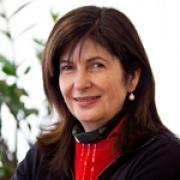Breaking the Silence of Osteoporosis
 Guest Post by Judy Stenmark, CEO
Guest Post by Judy Stenmark, CEO
International Osteoporosis Foundation
Meet Jeanie Joas. She’s an active woman in her 50s, who walks five miles at a time with weights, does yoga, spinning and recreational hiking, while supplementing all of these activities with a healthy, calcium-rich diet. What she thought were just two unrelated accidents three years ago—breaking her wrist while hiking and later fracturing a bone in her foot on a ski trip—turned out to be so much more: osteoporosis. Given her age, these fractures should have been a red flag for her doctors, but there was no recognition of the greater issue.
Then two years ago, Jeanie had a regularly-scheduled bone density test that indicated rapid, significant bone loss, despite her active lifestyle and healthy eating habits. Like so many patients, Jeanie and her doctors were shocked by the test results, but after a retest, they proved accurate. If her osteoporosis had been detected earlier, treatment could have started sooner and her second fracture may have been prevented.
Does this story sound familiar? Well, Jeanie is not alone.
Worldwide, one in two women and one in five men over the age of 50 will suffer a fragility fracture.
In the United States, 2 million broken bones occur every year (almost 5,500 every day) due to osteoporosis—not simply slips and falls.
In 2002, osteoporosis-related fractures in the United States cost an estimated $20 billion, and that number is expected to increase to approximately $25.3 billion by 2025.
Osteoporosis causes bone to become more fragile and weak, leading to an increased risk of fractures (broken bones). People with osteoporosis may experience a fracture even from a slight bump or a fall from standing height in the course of daily activities. Osteoporosis has no signs or symptoms until a fracture occurs, which is why it is often called a ‘silent disease’. Osteoporotic fractures most commonly occur at sites such as the wrist, upper arm, pelvis, hip and spine.
 In conjunction with the annual World Osteoporosis Day on October 20th, the International Osteoporosis Foundation (IOF) released a new report, called Capture the Fracture – A global campaign to break the fragility fracture cycle, which reveals approximately 80 percent of patients treated in clinics or hospitals following a fracture are not screened for osteoporosis or risk of future falls. Left untreated, these patients are at high risk of suffering secondary fractures and facing a future of pain, disfigurement, long-term disability and even early death, not to mention the healthcare costs.
In conjunction with the annual World Osteoporosis Day on October 20th, the International Osteoporosis Foundation (IOF) released a new report, called Capture the Fracture – A global campaign to break the fragility fracture cycle, which reveals approximately 80 percent of patients treated in clinics or hospitals following a fracture are not screened for osteoporosis or risk of future falls. Left untreated, these patients are at high risk of suffering secondary fractures and facing a future of pain, disfigurement, long-term disability and even early death, not to mention the healthcare costs.
IOF’s report and World Osteoporosis Day campaign—with participation from more than 90 countries—intends to educate physicians and patients about the importance of osteoporosis screenings to prevent future fractures, thereby reducing healthcare costs in the process.
To assess osteoporosis risk and reduce the likelihood of future fractures, talk to a doctor about a mineral bone density test and a fracture risk assessment. People with a previous osteoporotic fracture are twice as likely to suffer a second one, so it’s important to appropriately diagnose and treat the condition before it becomes a greater issue.
As the winter months fast approach and the incidence of slips and falls increases, it’s especially important to monitor risk for osteoporosis and take action accordingly for yourself and the people you care for. To learn more, click on Capture the Fracture campaign and World Osteoporosis Day.
Judy Stenmark serves as the International Osteoporosis Foundation’s (IOF), Chief Executive Officer after serving as the IOF’s Chief Operating Officer for 3 years. She was appointed to the Board of the IOF in 2004 and was Chair of the Committee of National Societies for the IOF. Judy has a medical background in physiotherapy and public health.








